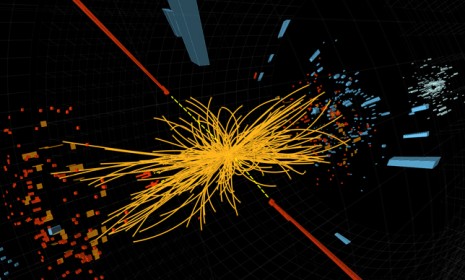The new, 'tantalizing hints' of the 'God particle'
Physicists excitedly announce that they are closing in on the mysterious Higgs boson — which is believed to have played a key role in our universe's creation

After months of subatomic particle smashing, two teams of researchers at CERN, the European Center for Nuclear Research, announced Tuesday morning that they've each recorded hints of the elusive Higgs boson, better known as the universe-creating "God particle." Here's what you should know:
What exactly is this "God particle"?
The Higgs boson is an elusive, subatomic particle "that was predicted to exist nearly 50 years ago," says Alok Jha at Britain's Guardian. And though scientists have been hunting for evidence of the particle for decades, they've had "no solid proof that it was real." Still, physicists have long believed that the mysterious "God particle" was an essential building block for the universe.
The Week
Escape your echo chamber. Get the facts behind the news, plus analysis from multiple perspectives.

Sign up for The Week's Free Newsletters
From our morning news briefing to a weekly Good News Newsletter, get the best of The Week delivered directly to your inbox.
From our morning news briefing to a weekly Good News Newsletter, get the best of The Week delivered directly to your inbox.
What exactly is this "God particle" supposed to do?
Immediately after the universe was created by the Big Bang nearly 14 billion years ago, "all the particles in the cosmos weighed nothing at all and zipped around chaotically at the speed of light," Jha says. Researchers believe that a mere trillionth of a second later, a field of "God particles" somehow "switched on," acting as a "cosmic glue" to slow other particles down and give them mass, thus allowing for the eventual formation of stars and planets. Without the Higgs field to give objects mass, all those particles would still be flying around, and the universe as we know it wouldn't exist.
So what did researchers discover?
The Higgs is quite difficult to find, largely because if it exists, it disappears or transforms into another particle so quickly that it can't be measured. But two giant teams of CERN scientists announced on Tuesday that they'd seen "tantalizing hints" of the particle after "sifting debris from high-energy proton collisions," says Dennis Overbye at The New York Times. The two teams, consisting of roughly 3,000 physicists each, came to these results independently, which is giving other scientists hope. The CERN scientists saw bumps in their data that helped them narrow down the atomic weight of the "putative particle," which, if it exists, weighs between 115 to 127 billion electron volts — well more than 100 times as much as a proton.
A free daily email with the biggest news stories of the day – and the best features from TheWeek.com
What now?
The two teams expect to have enough data to make a definitive conclusion by summer 2012. "The simple fact that" both teams "seem to be seeing a data spike at the same mass has been enough to cause enormous excitement in the particle physics community," says Paul Rincon at BBC News. "Finding the Higgs would be one of the biggest scientific advances of the last 60 years."
Sources: BBC News, Guardian, New York Times
-
 ‘It’s hard not to feel for the distillers’
‘It’s hard not to feel for the distillers’Instant Opinion Opinion, comment and editorials of the day
-
 A long weekend in Fontainebleau
A long weekend in FontainebleauThe Week Recommends Less than an hour from Paris, this historic town is perfect for a short break
-
 Political cartoons for December 16
Political cartoons for December 16Cartoons Tuesday’s editorial cartoons include calibrating fonts, Christmas classics, and more